Virtual reality (VR) headsets have huge market potential, but according to major research companies, only 1.4 million to 12.8 million units were sold during 2016. Most VR headsets are sold as accessories for mobile devices, and only 4% are for PCs. NVIDIA's strategy is "If you want, you can buy a computer and then have a corresponding VR headset" to sell more high-performance GPUs for the PC industry.
Virtual reality marketNVIDIA is a leading supplier of graphics processing units (GPUs) that provide real-world images for computer games, and NVIDIA has a market share of approximately 70%. The virtual reality (VR) headset device market has a strong development momentum and has broad development prospects in video games, personal media and video conferencing. However, its actual growth has been in dispute, for example, according to an article published by Fortune Magazine on July 7, 2016:
“The speed of development of virtual reality is fast, and analysts’ views are different. According to market research firm TracTIca, in the high-end market, all types of VR headsets, supporting controllers and accessories are included. Within this year, a total of 20 million units can be sold. Neil Schneider, executive director of the immersive technology alliance, has a much lower estimate. He expects high-end market shipments to reach 300,000 units in 12 months. He goes further. It says that sales of cheap VR hardware like Samsung Gear, which relies on smartphones instead of PCs, can reach 3 million units. Looking ahead, the market tracking agency Digi-Capital has lowered its optimism about the virtual and augmented reality markets. It is estimated that the estimate has dropped from the previous $150 billion to $120 billion."
NVIDIA recognizes the possibility of VR headsets using their GPU chips, the company wrote on its official website:
“Virtual reality will change the way we watch performances, interact with friends, and do our daily work. As a leader in visual computing, NVIDIA is at the forefront of this exciting new computing platform for virtual reality. From gaming to product design. , and then to the viewing experience, etc., NVIDIA offers a series of breakthrough solutions for industry-leading Pascal architecture GPUs, drivers, SDKs, including VR, to meet the needs of professionals, players and developers. demand."
Researcher Jon Peddie said:
"High-end GPU applications - the gaming PC segment will continue to bring growth opportunities to PC makers. The new gaming content and the great prospects of virtual reality are helping to drive demand for gaming-grade desktops and laptops."
IDC stated:
“By the end of 2016, augmented reality and virtual reality device shipments will reach 10.3 million units, of which there will be only 100,000 augmented reality devices. By 2020, shipments of virtual reality headsets will reach 61 million units. The compound annual growth rate is 100.7%."
However, Reuters mentioned in an article published on December 18:
“Broker Piper Jaffray lowered the sales forecast for VR headsets by 65% ​​to 2.2 million in an unpublished report.â€
Gartner predicts that shipments of VR headsets will be 1.43 million units in 2016 and 6.13 million units in 2017.
Table 1 gives the forecast figures for major research companies.
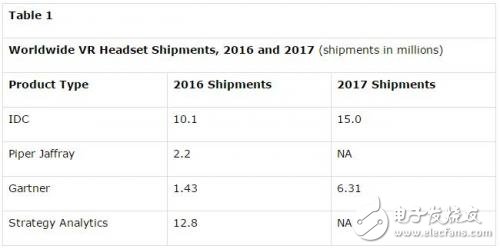
The problem is that the growth in VR headset shipments is largely due to the type of handset-based devices, and only 4% of the total sales in 2016 were for PCs.
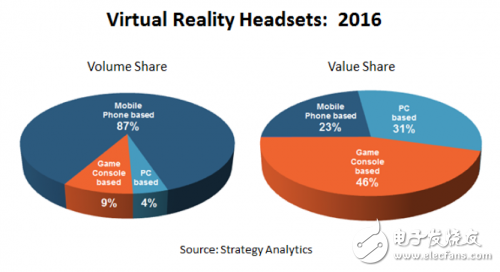
According to a new research report by Strategy AnalyTIcs:
"2016 global revenue for VR headsets will reach $895 million, of which 77% will come from Facebook-Oculus, HTC and Sony's new high-end devices, and on the shipping unit, the three companies With a share of only 13%, other smart phones-based devices dominate the virtual reality headset market with shipments of up to 12.8 million units."
VR market and NVIDIAThe small PC-based VR device market is divided by NVIDIA and AMD. According to the data shown in Table 2, the shipment of desktop discrete graphics in the second quarter of 2016 was 9.44 million, and Nvidia's market share was as high as 70%.
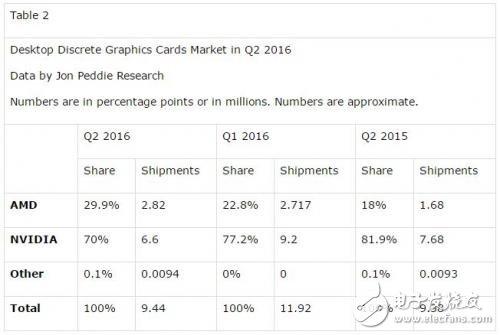
Mercury Research has slightly different market share statistics, and it also extracts GPU sales data for mobile devices.
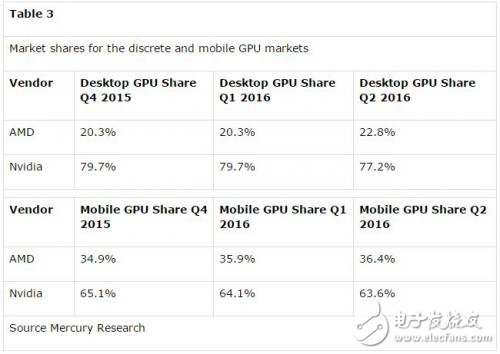
Based on the estimated VR headset shipments, and based on the current price of the GeForce GTX chip (with AMD's chip price below $350, NVIDIA should lower its chip price in 2017, but now we It can still be assumed that the price of each PC graphics card is $400), and Table 4 is produced.
NVIDIA puts the minimum configuration requirements in the VR Ready program, the GeForce GTX 970 for desktops and the GTX 980 for laptops. The GTX 970 currently has a suggested retail price of $329.99 and the GTX 980 is $499.99.
According to current forecasts for VR headsets, NVIDIA's revenue in this area is only $16 million to $143 million. Interestingly, unit shipments range from 60,000 to 500,000.
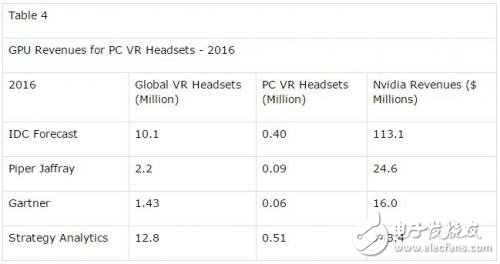
However, VR headsets and VR ready computers are two different products. NVIDIA General Manager Zvi Greenstein confirmed at the VRX conference in San Francisco that system manufacturers have sold 15 million VR-ready computers with Geforce graphics cards so far. He estimates that by the end of next year, the number of VR systems equipped with Geforce will increase to 30 million.
I explain his remarks. With the installation in previous years, by the end of 2016, the number of VR-ready computers equipped with GeForce will reach 15 million. In addition, 15 million units will be sold in 2017, by the end of 2017. The total installed capacity will reach 30 million units. So, assuming $400 per GPU, NVI will generate $6 billion in revenue on the VR system's Geforce GPU in 2017, compared to $16 million to $143 million based on VR headset estimates. Compared to the income of the dollar, the difference is obviously very large.
According to the earnings report released by Nvidia, GPU revenue in the first three quarters of 2016 was US$2.7 billion, equivalent to US$3.6 billion for the whole year of 2016. According to the price of US$400, it is equivalent to 9 million GeForce-equipped VR. computer. Compared with the actual unit shipments of PC-based head-mounted devices from 60,000 to 500,000, the difference is still very large.
Both Oculus and HTC have released official recommendations for PC system requirements. Interestingly, the specifications presented by the two are almost identical, and are the same as the desktop GPUs mentioned above by NVIDIA.
HTC Vive
Graphics card: GeForce GTX 970 or AMD Radeon R9 290 or higher
CPU: Intel Core i5 4590 or AMD FX 8350 or higher
RAM: 4GB or more
Video port: HDMI 1.4, DisplayPort 1.2 or better
USB port: 1 USB 2.0 or faster port
Windows 7 SP1 or higher
Oculus Rift
Graphics card: GeForce GTX 970 or AMD Radeon R9 290 or higher
CPU: Intel Core i5 4590 or higher
RAM: 8GB or more
Video port: HDMI 1.3
USB port: 2 USB 3.0 ports
Windows 7 SP1 or higher
In 2016, desktop and notebook shipments are estimated to reach 258 million units, down 6.4% from 2015. In 2017, IDC expects shipments to continue to decline by 2.1% to 225.7 million units.
In terms of the proportion of shipping units, 9 million VR-ready computers equipped with GeForce graphics cards accounted for 3.5% of all computers in 2016, while 15 million VR-ready computers equipped with GeForce graphics cards accounted for all computer sales in 2017. 5.9%.
Let us look a little further. IDC forecasts shipments of VR headsets to 10.1 million units in 2016 and 61 million units in 2020. Based on the same assumptions, the average selling price of the graphics card is $400, PC-based head-mounted devices account for 4%, and Nvidia has a 70% market share. Nvidia will sell 2.44 million graphics cards, resulting in a sales revenue of 6. 8.3 billion dollars.
Key pointsNVIDIA has developed a strategy - "If you want, you can buy a computer and then have a corresponding VR headset" to provide PC vendors with GeForce GPUs that meet Oculus and HTC settings. In other words, VR headsets are not the main market for game-level GPUs. According to the above calculations, VR headsets will contribute $683 million to NVIDIA by 2020, which is only a fraction of the $6 billion in revenue that Nvidia expects to generate in the gaming GPU market in 2017. The key to NVIDIA's strategy is to market as many GeForce GPUs as possible with VR performance to PCs, whether buyers have VR headsets or not.
On the other hand, considering the increasing competition from AMD, NVIDIA will launch competitive products at lower prices.
"AMD confirmed in a press release that the company will launch the Polaris 10 and Polaris 11 graphics chips based on the new FinFET process in the fourth quarter of this year. Its target market is the graphics card market, which costs less than $350. Interestingly, JPR found that only 15% of AMD's products sell for $349 or more, and only 3% of the 15% GPUs cost $449 or more, which means that compared to AMD's Polaris GPU targets a significantly larger market segment than NVIDIA's GTX 1080 and GTX 1070."
Film capacitors are electrical capacitors with an insulating plastic film as the dielectric, sometimes combined with paper as carrier of the electrodes. These plastic films are sometimes metalized and are available in the market under the name metalized Film Capacitor,these capacitors are sometimes also called plastic capacitors.
Film Capacitor,X-Ray equipment Capacitor,Axial Polyester Capacitor,Polypropylene High Voltage Capacitor
XIAN STATE IMPORT & EXPORT CORP. , https://www.capacitorhv.com